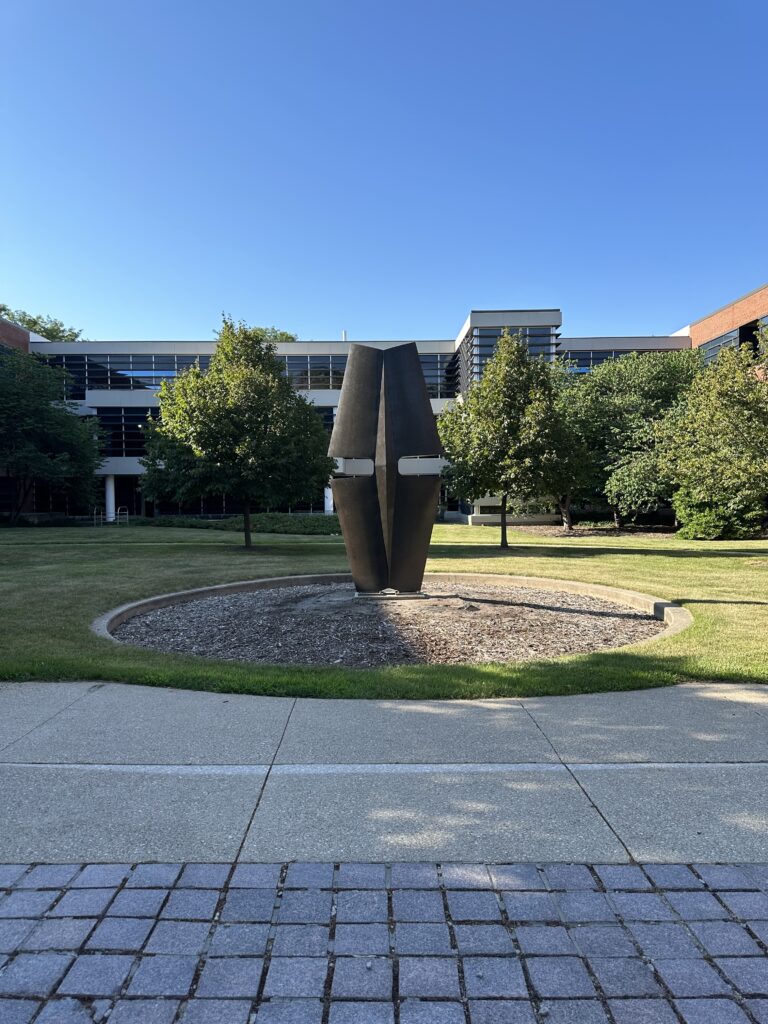
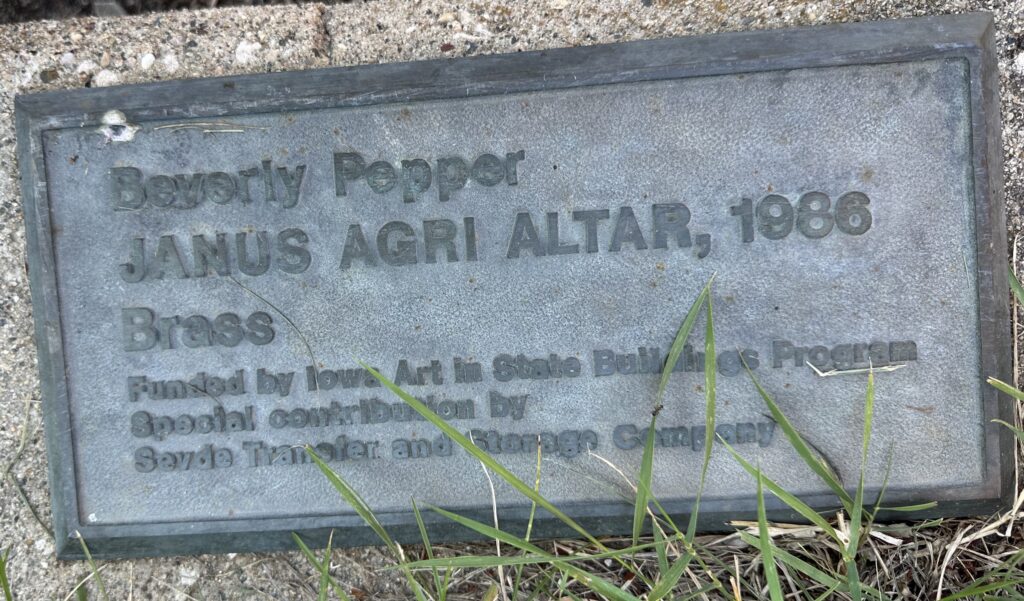
About the Art
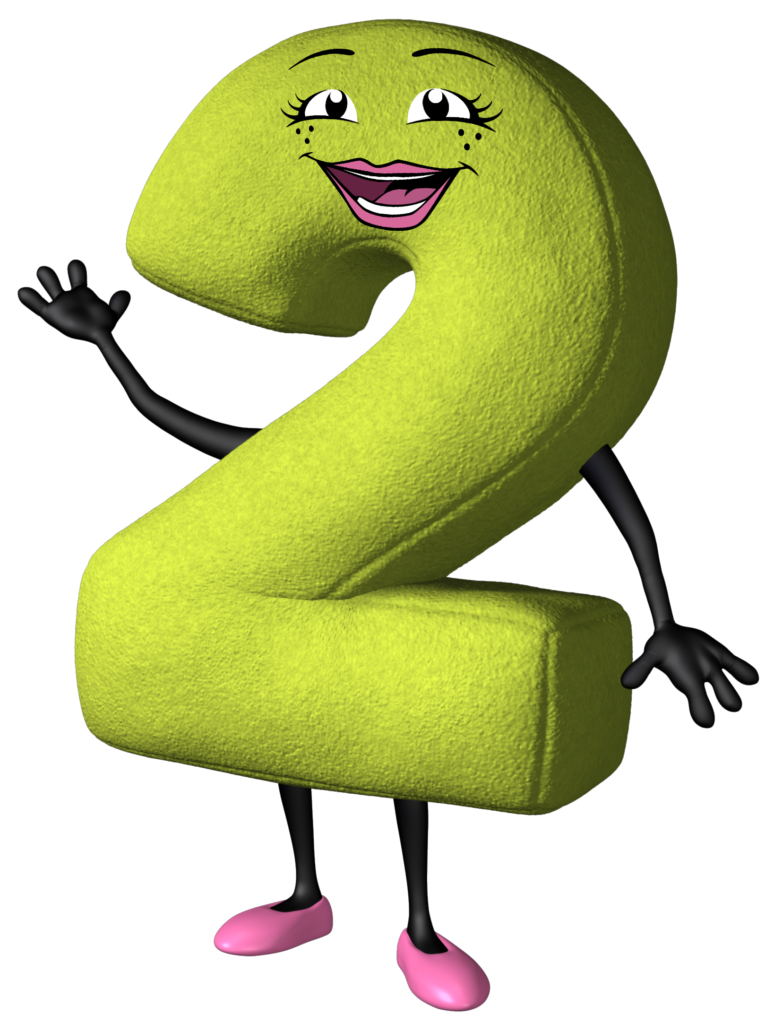
Beverly Pepper created the sculpture Janus Agri Altar which was installed in 1986. It is a reference to the Roman god Janus who is the protector of time portals/doorways through which humanity passes through. Not only is the sculpture a gateway, but it is also a connection to the month of January. The first month of the year is derived from the word Janus; it ends the old year and starts the new year.
The Roman god Janus is normally depicted horizontally. Janus is also typically represented with two bearded heads placed back-to-back so that he might look in all directions at once. Pepper created the sculpture vertically, reminiscent of an image reflected in a pool of water. Janus Agri Altar is a sign of self-reflection, looking both inward and outward as well as forward and back. An altar is a place where one refreshes the spirit and looks inside oneself. Pepper created a peaceful symbol.
Janus Agri Altar has a double meaning in its form. It is depicted with two heads, one viewing the future and one viewing the past as in the portrayal of the Roman god— as well as in the shape of an adze, an ancient digging tool. Pepper notes state that “today’s tools are too sophisticated to engender any visual dialogue in the context of my work. For this reason, I researched antique farm tools common to the area. I focused on a farmer’s spade, and taking this simple form to its furthest extreme, the imagery was transformed. One could not identify the sculpture as a farmer’s spade without some knowledge of this process.”
Located in the south courtyard in the Agronomy Hall, the altar sculpture is placed within a ritual ring that suggests continuity and eternity through the ages. The ring also suggests religious and spiritual ties of agriculture and the homage which humanity must pay since all humans are dependent on agriculture.
In 1992 Iowa State University University Museums commissioned four poems inspired by Janus Agri Altar.
Janus by Robert Dana 1992
Not two-faced,
but two faces.
alter and icon.
Not just blade,
but both edges.
Cutting down
or cutting up.
East or West.
North or South.
Nothing cleanly
simple’s simple.
Doubleness by Ann Struthers 1992
Doubleness
of this blade, like a plow,
symbol of Iowa,
that tore the prairie, the share that breaks
the binds: liberates soil’s richness,
opens passages for the breath
of agriculture; builds barns, silos,
grain elevators, feedlots, hog confinements;
the other side of the share
cuts off buffalo, Native Peoples,
plows under oceans of prairie lilies,
the red and gold prairie grasses
all the creatures that lived
in their beneficent shadows.
The wild sacrificed
to the tame, the unexpected to the usual,
meandering path of the fox and coyote
to geometric squares
of the surveyor. This is the instrument
for making straight when everyone knows
the crooked is more beautiful.
Janus Agri Altar by Mary Swander 1992 (2009 Iowa Poet Laureate)
Look forward, back, forward, back.
Look out. Look up and down again,
my face, my face, a blade, a plow.
I watch to keep the furrow straight.
I rip the sod, drain the slough.
I plant the seed, the pod, the chaff and grain.
For these are prime:
first hour of the day, the month, the year,
first rain of spring, frost of fall.
Root hair, root cap, peduncle and peg,
ground turned under, alter of flower and grass.
Big stem, blue stem, violet, sweet william,
I dig the worm. I split the skin.
I see the sea, the dirt, the floor,
swing open the gates, the heavy doors.
For in the beginning is the end,
and the end is smooth, real, polished steel.
For in the beginning is the end
when all returns to dust, to rust,
to one more happy meal.
To one more cell, one more leaf and stalk,
I call look up, look out, look forward, back,
to celebrate our sumptuous plate,
to mourn our prairie lost to corn.
Thieves by Ann Struthers 1992
This double bronze is also
double brass when Michael Carey
and Neil Bowers one winter afternoon rub
their gloves across its striations, pluck music
from its hollows.
Tap its sounding boards for gongs, cymbals, kettle drums.
Their rhythms resound in this Agronomy Quadrant,
poets making themselves heard, stealing art
from musicians and sculptors. (Poets are
the finest thieves in the world. Paris
pickpockets are amateurs compared
to the most common poet.)
I have stolen the music from Michael
and Neal, which they stole from the sculptors,
Beverly Pepper, which she stole from John Deere,
and the inventor of the snow plows, the inventor of Roman gods, and a few others.
I have stolen two or three minutes from your left wrist.
intend to steal more if I can. But I have given you
something, too. Put your fingertips in your right
pocket’s cave. Even if you can’t find it now,
it’s there, waiting for you to recognize it,
something changeable and unchanging,
metaphor, music, instrumentation.
About the Artist
Beverly Pepper (1924-2020) was born in New York City and studied at the Pratt Institute and the Art Students League in New York. She also studied at the Academe de la Grande Chaumiere in Paris under the advisement of Fernand Leger and Andre Lhote. From 1949-1960 she focused her art on painting, seen in her first solo exhibition in 1952 at the Galleria dello Zodiaco in Rome. Soon after she shifted her focus to creating monumental outdoor sculptures for public spaces that can be viewed throughout the United States and Europe. In 1987 Pepper returned to painting, incorporating the gestural, expansive, and colorful elements drawn from the power of nature that she used in sculpting.
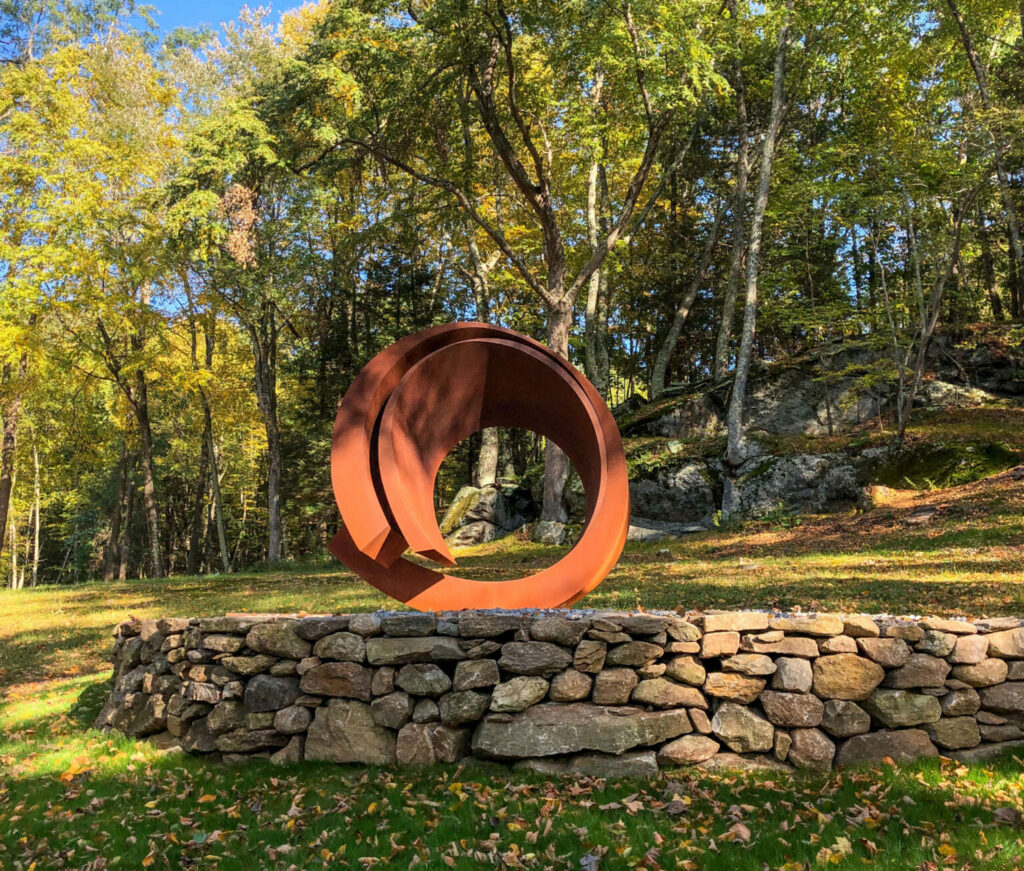
Clodia Medea, 2014, Cor-ten steel, James Barron Art, Kent, Connecticut

Denver Monoliths, 2004-2006, Denver Art Museum, Denver, Colorado
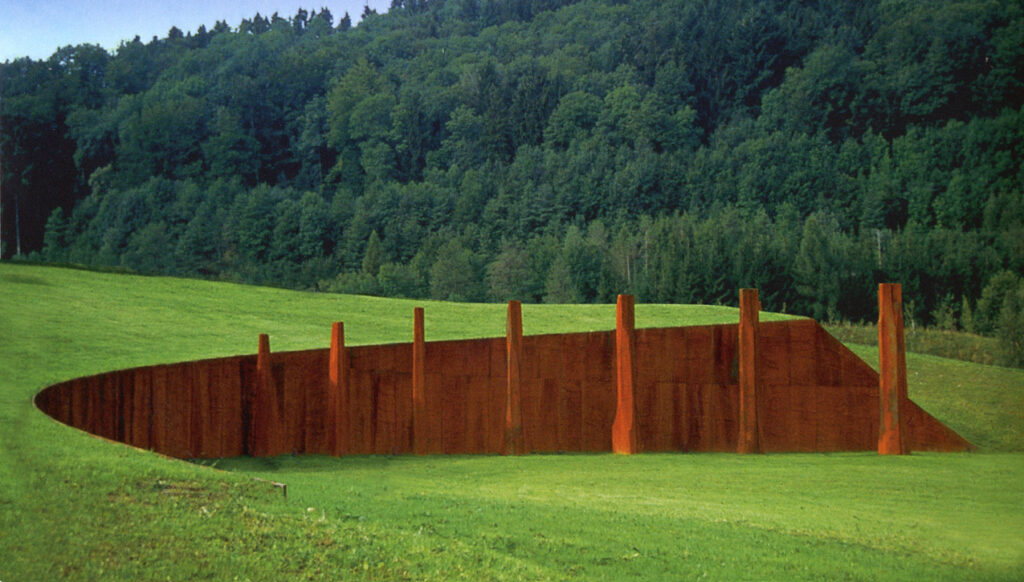
Palingenesis, 1993-94 Cast iron, Suisse, Horgen, Switzerland

Amphisculpture, 1974-75 Cement, Grass 8 x 270 x 14 ft (2,44 x 82,30 x 4.27 m) AT&T, Bedminster, New Jersey
Relevant Terminology/History
In ancient Roman religion and myth, Janus is the god of beginnings, gates, transitions, time, duality, doorways, passages, frames, and endings. He is depicted as having two faces. Janus presided over the beginning and ending of conflict, and thus war and peace. The gates of a building in Rome named after Janus were opened in time of war, and closed to mark the arrival of peace. As a god of transitions, Janus had functions pertaining to birth and to journeys and exchange.
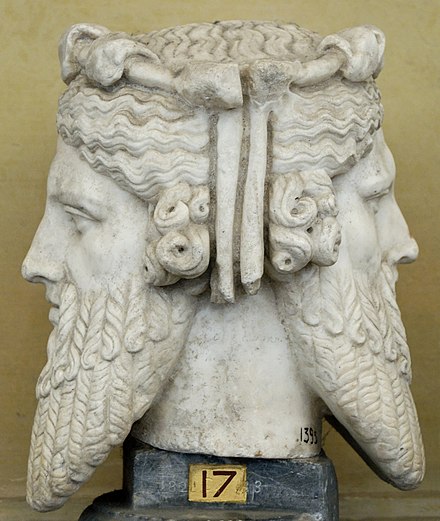
Statue representing Janus Bifrons in the Vatican Museums, Vatican City, image courtesy of Wikipedia.
The month of January is named for Janus, the god of beginnings and transitions in Roman mythology. January is the first month of the year in the Julian and Gregorian calendars. The original Roman calendar consisted of 10 months totaling 304 days, winter being considered a month-less period. Around 713 BC, the semi-mythical successor of Romulus, King Numa Pompilius, is supposed to have added the months of January and February, so that the calendar covered a standard lunar year (354 days).
Various Christian feast dates were used for the New Year in Europe during the Middle Ages, including March 25 (Feast of the Annunciation) and December 25. Beginning in the 16th century, European countries began making January 1 the start of the New Year once again—sometimes called Circumcision Style because this was the date of the Feast of the Circumcision, being the seventh day after December 25.
Historical names for January include its original Roman designation, Ianuarius, the Saxon term Wulf-monath (meaning “wolf month”) and Charlemagne’s designation Wintarmanoth (“winter / cold month”).
Agronomy is the science and technology of producing and using plants by agriculture for food, fuel, fiber, chemicals, recreation, or land conservation. Agronomy includes research of plant genetics, plant physiology, meteorology, and soil science.
Adze or adz is an ancient versatile cutting tool with the cutting edge perpendicular to the handle. Adzes have been used since the Stone Age. They are used for smoothing or carving wood in hand woodworking, and as a hoe for agriculture and horticulture. Two basic forms of an adze are the hand adze (short hoe)—a short-handled tool swung with one hand—and the foot adze (hoe).
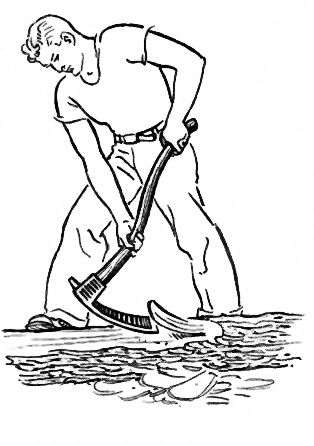
Adze image courtesy of Wikipedia.
An altar is a table or platform for the presentation of religious offerings, for sacrifices, or for other ritualistic purposes. See examples below.

Altar of Pergamon, reconstructed at the Pergamon museum, Berlin, image courtesy of Wikipedia.
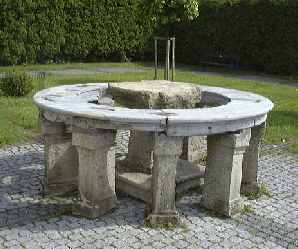
The Opferstein or Sacrifice Rock at Maria Taferl, Austria, image courtesy of Wikipedia.
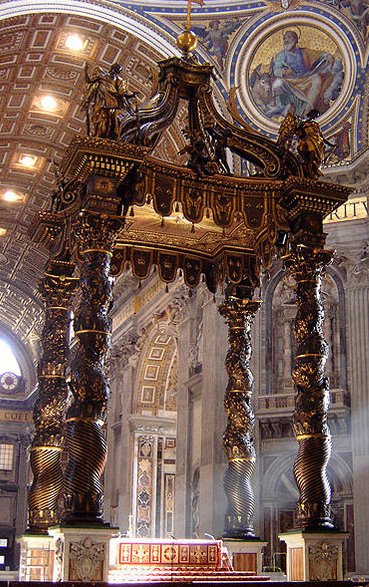
High altar of Saint Peter’s Basilica, Rome, Italy, image courtesy of Wikipedia.
Minoan Double Ax – In ancient Crete, the double axe was an important sacred symbol of the Minoan religion. In Crete the double axe only accompanied goddesses, never gods. It was the symbol of the arche of the creation (Mater-arche). Small versions were used as votive offerings and have been found in considerable numbers. Minoan double axes have also recently been found in the prehistoric town of Akrotiri (Santorini Island).
All of the following images were taken by Dr. Rebecca Klemm during her archaeological trip to Greece and Turkey during September – October 2022.
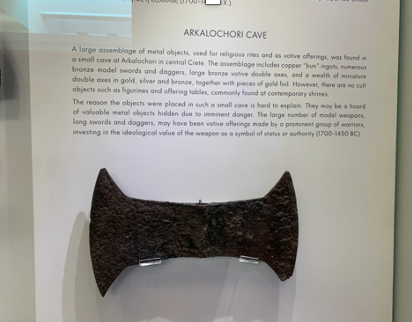
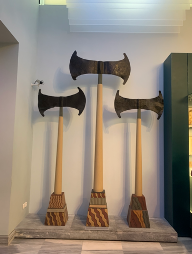
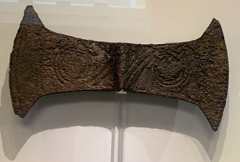
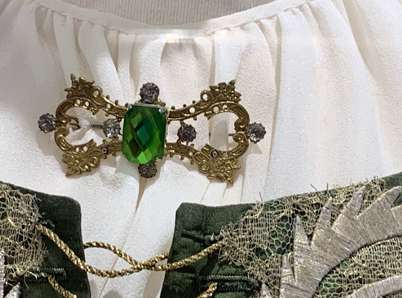
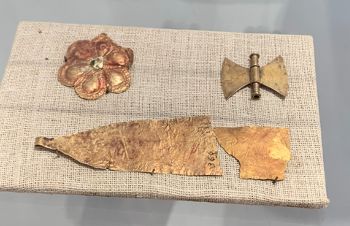
The double axe design was incorporated into jewelry and made of gold.
The double ax design was also used to repair or strengthen items constructed of stone, ceramics, or wood. Dr. Rebecca Klemm took this image while walking by an archeological site in Crete.
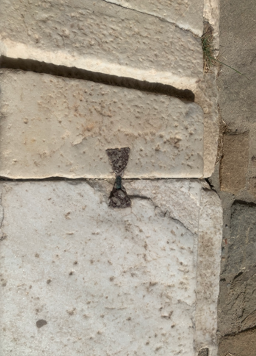
While double axes are common in modern high fantasy settings, in reality they were not commonly used in combat. During the Middle Ages double-headed axes may have been used in battle.
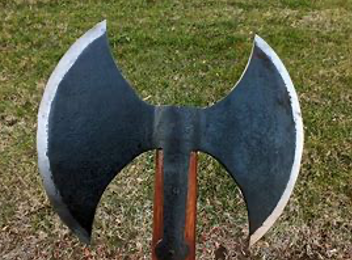
Image courtesy of Wikipedia.
Learning Guide

- What do you think the title has to do with the art?
- Why do you think Number Character 2 is speaking about the art?
- Why do you think Number Character 1 is speaking about the art?
- How does the red image with white numbers relate to the art? Can you find the shape in the art?
- How does the hidden blue image relate to the art? Can you tell which garden tool is presented in a double fashion? Have you ever used one?
- What angle is created by the handle of the adze if it is perpendicular to the cutting edge? Why?
- Have you ever been to an altar? If so, where?
- Why do you think October is not the 8th month of the year? September not the 7th November not the 9th December not the 10th? What influence of two Roman Caesars may have shifted the month names?
- Have you ever seen a piece of wood or ceramic vessel repaired with a piece that looks like a Minoan double ax?
- Which of the four poems do you like best? Why?
- Do you know what is means to be named a Poet Laurent?
- Would you like to be Janus, where you have two heads back to back? Why?
